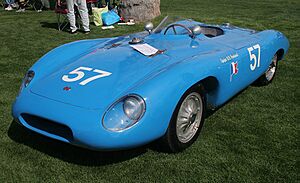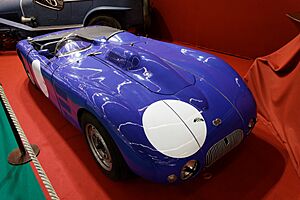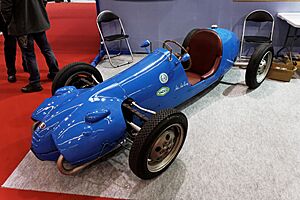DB (car) facts for kids
Deutsch-Bonnet (DB) was a cool brand of sports cars made in France. It was started in 1937 by two friends, Charles Deutsch and René Bonnet, and it stopped making cars in 1962.
| Industry | Automobile |
|---|---|
| Founded | 1937 |
| Founder | Charles Deutsch, René Bonnet |
| Defunct | 1962 |
| Headquarters | Champigny sur Marne,
France
|
| Products | Sports cars, automotive engineering |
DB cars, especially their Coupés, were very famous in races and rallies around the world. They competed in big events like the 24 Hours of Le Mans, 12 Hours of Sebring, and the Tour de France Automobile. Even Prince Rainier of Monaco drove a DB car, which helped make the brand well-known!
Contents
History of DB Cars
The company, first called Deutsch-Bonnet, became known as DB after 1947. It was a French car maker from 1938 to 1961. Their workshop was located near Paris, in a place called Champigny-sur-Marne.
The company was founded by Charles Deutsch and René Bonnet. René Bonnet had taken over the Deutsch family's car body-building shop in 1932. Before World War II, they focused on building very light racing cars. After the war, they also started making small sports cars for people to drive on the road. Their first road car was a convertible based on a Panhard Dyna X car, shown in 1950.
DB worked closely with Panhard, another car company. By 1952, DB cars were even shown as special attractions on the big Panhard stand at the Paris Motor Show. This showed how much the two companies helped each other.
The DB company stopped making cars by 1961. This happened because Charles Deutsch and René Bonnet started to have different ideas about how to design cars. It's not exactly clear how many DB cars were built, but it's thought to be around one thousand.
Making Cars Light and Fast
DB was known for making very light sports cars. At first, they used steel or aluminum for the car bodies. Later, they started using fiberglass, which is a very light and strong material. Most DB cars used small engines from Panhard. These were usually flat-twin engines, meaning they had two cylinders that lay flat. Their sizes were typically 610, 744, or 848 cubic centimeters.
Charles Deutsch was a "theoretical engineer." This means he was great at understanding how things like air resistance (aerodynamics) affected a car's speed. René Bonnet was more of a "practical mechanical engineer." He was good at building and making things work.
The fiberglass bodies of DB cars were built over a special frame. This frame was made of steel tubes and ran down the center of the car. The cars also had front wheel drive and a special suspension system on all four wheels. These parts were taken directly from Panhard cars. Before 1952, all DB cars were made only for racing.
How DB Started Racing
René Bonnet was supposed to race for another company in 1936, but it didn't happen. So, he and Deutsch decided to build their own racing car! Their first special car was the 1938 DB1 roadster. It was made from parts of a Citroën Traction Avant car and took 17 months to build.
After the DB1, they built more cars, each with a new number. The DB3 was a special design project during the war, but it was never built. Instead, they focused on the DB4, which was finished in 1945. It had a central frame and used a 1.5-liter engine from a Citroën. The very similar 2-liter DB5 was finished soon after. These two cars were the only new cars in the first race in France after the war, and they both did well!
Later, DB started using Panhard car parts because it was hard to get Citroën parts. This partnership began when Deutsch offered to design a racing car for a club using a Panhard 500 engine. One club member asked DB to build this car. It was a big hit at the 1949 Paris Motor Show, and Panhard was happy to help build about 15 more.
DB was very active in racing, especially in the Le Mans 24 Hours and other long-distance races. Almost all DB cars, even the ones for the road, were designed with racing in mind. In 1952, a DB Speedster raced in the 12 Hours of Sebring in the United States and won its class easily. This helped DB become known in America.
At the 1954 Le Mans race, DB entered five of its own cars. René Bonnet himself, along with racer Élie Bayol, finished tenth overall. This was the best result for a DB car that year.
DB Road Cars
After focusing on racing, DB also started making cars for people to drive every day. The 1949 DB8 was a beautiful car, but Citroën wouldn't provide parts for it to be mass-produced. So, DB started using Panhard engines.
One of their first road cars was a convertible designed by Antem. It was about 3.75 meters (12.3 feet) long and weighed about 500 kilograms (1,100 pounds). It used a 750 cc Panhard engine. An 850 cc version was also available, which could go faster, up to 140 kilometers per hour (87 mph). About 20 of these convertibles were built in 1951.
DB then made a coupé (a car with a fixed roof) version of this car. These were mostly used for racing. They also used Panhard parts and a central steel-tube frame.
In 1952, DB introduced the "Mille Miles" car. This car celebrated their class victories in the Mille Miglia race. It was a small, sporty car with a 65 horsepower Panhard engine. It was a bit expensive.
Their most successful car was the HBR 4/5 model, made from 1954 to 1959. Several hundred of these small cars were produced. After that came the Le Mans convertible and hardtop, shown in 1959. DB built these until 1962, and another company continued to build them until 1964. About 660 Mille Miles/Coach/HBR cars were made, and 232 DB Le Mans cars. Later versions could even have bigger engines or superchargers for more power. DB cars were often custom-built, so no two cars were exactly alike!
More Racing Wins
Charles Deutsch was very good at designing cars that cut through the air easily. This is called aerodynamics. Because of his designs, DB race cars could go very fast, even with their small Panhard engines.
DB cars won many class victories in big races. They won at Le Mans three times, Sebring twice, and Mille Miglia four times! They even won the 1954 RAC Tourist Trophy sports car race. DB cars were especially good in the "Index of Performance" category. This category rewarded cars that were efficient and performed well for their engine size. DB's small, aerodynamic cars were perfect for this!
The End of the Partnership
Charles Deutsch and René Bonnet eventually had different ideas about how to build cars. They disagreed on whether cars should have front-wheel drive or mid-engines. They also couldn't agree on which engines to use.
Because of these disagreements, Charles Deutsch left DB in 1961. He started his own company called CD. René Bonnet then started his own company, Automobiles René Bonnet. He made cars with mid-engines and used Renault engines. This company later became part of Matra Automobiles. Charles Deutsch became an engineering consultant, helping other companies with their designs.





